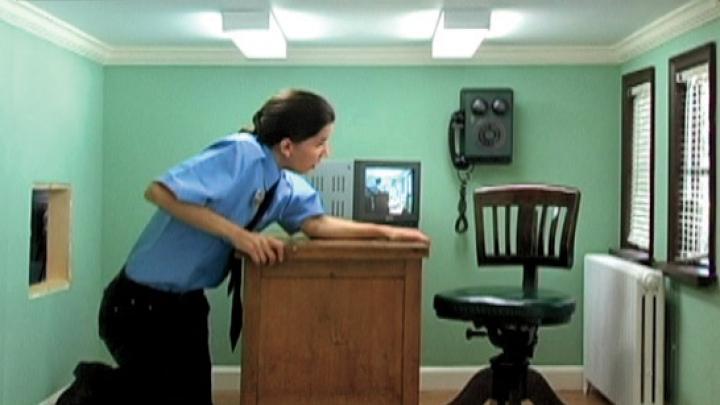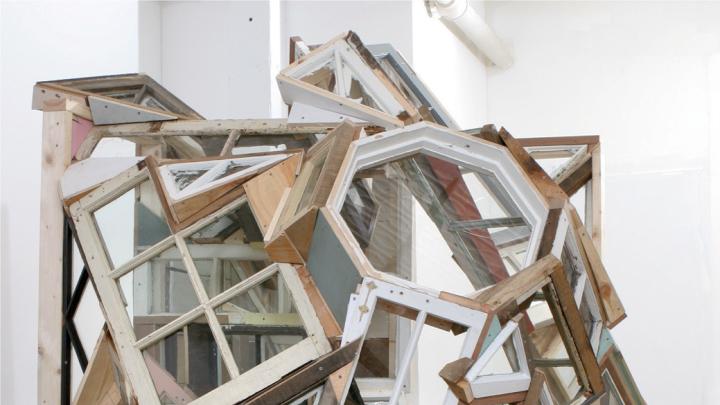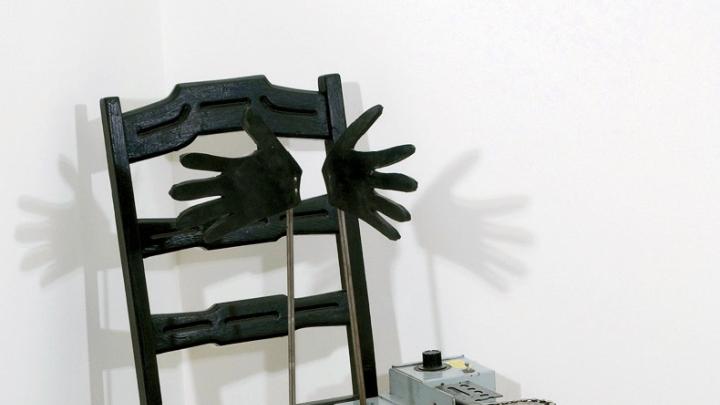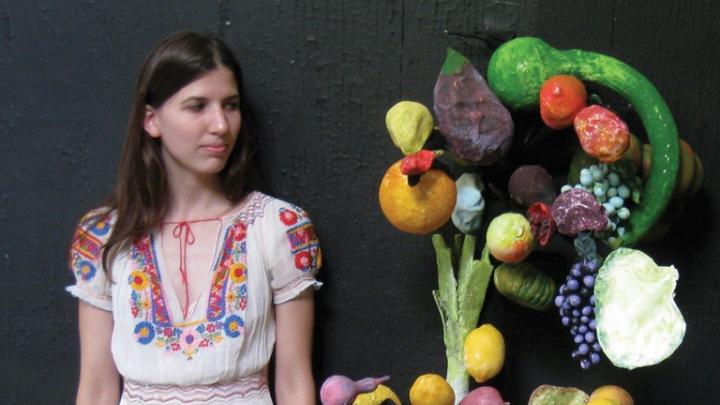In the video called Day Shift, a security guard sits in a small office, watching a monitor that shows the room she’s in. The phone rings. Nobody’s there. Again the phone, again no one’s on the other end. No matter, it’s 5 p.m. The guard walks to her car. Looks back—her rear window is bricked in. Nonetheless, a section of the window slides open. She crawls into the backseat and through the rear window, emerging in the monitor on her office desk. The office is different now—the ceiling’s lower. The phone rings. Yet again the caller is silent. And as a small building is slowly pulled backward on the lawn of a country estate, there is applause.
The inspiration for this video might have been the 1999 film Being John Malkovich. But that cult favorite would be too direct for Meredith James ’04, the artist who also cast herself as the uniformed security guard in her video. Her idea of an inspiration for a video or sculpture is more likely traceable to a Surrealist film by Jean Cocteau or a literary science-fiction novel. Not on her list: ideas that come from drawing, painting, and sculpture. “When I draw,” she says, “I feel I’m looking at my own handwriting. The words may surprise me, but it feels familiar.”
Her art is anything but familiar. “My intent is to show parallels between the world you imagine in your mind and the world we inhabit,” she says. “I want to level that playing field.” So in her large, nearly empty studio in a nondescript section of Brooklyn, James, now 29, makes videos and sculptures that distort architectural space and play with perception. “My continuing interest,” she says, “is disruption.”
A typical piece is See-Through (2007), an assembly of salvaged wood and windows, arranged in a kind of cupola. “You look into a window,” she explains, “but instead of seeing inside, you see another window. Soon you’re looking into a tunnel of windows. It’s a formal problem for me now, but it started out as a dream in which I walked up to a house, looked in—and saw out the side window.”
Corridor (2009), created from a dry-cleaner’s conveyer rack, is a distant echo of a shot of the spooky hotel corridor in Stanley Kubrick’s 1980 film The Shining. Its intent: “to turn visual imagery into a physical object.” The video Present Time (2009) shows what seems like the peeling off of endless layers of lacy fabric as curtains of a proscenium stage are pulled back, only to reveal another curtain.
This is not, for James, art that we should take entirely seriously. In Applause, a sculpture she made at Yale, where she earned an M.F.A. in 2009, two rubber hands, powered by a motorized bicycle chain, sit upon a chair and clap repeatedly. “As an artist, you end up having to be your own audience a lot, because you’re alone so much of the time,” James explains. “But really, the piece is a joke. I’m laughing at myself and my desire for approval. When I showed it to my professors, I started with it switched off. Then I turned the machine on, because I knew there’s no clapping in grad school.”
The eldest of three children of economist Amabel (Boyce) James and financier Hamilton James ’73, M.B.A. ’75, she sewed her first costume when she was seven but didn’t read until she was in the second grade. At Harvard, where she concentrated in visual and environmental studies, she was the one in the second row at the Brattle Theatre, lost in the surrealistic special effects, or hunched over a sewing machine at the Loeb Drama Center. The source of her disruptive hopes for her art? In large part, her aesthetic is a reaction to the stability she experienced as a child in New York and a student in Cambridge.
“At Harvard, you’re always aware of the history,” she explains. “In the bricks, even—the new ones look just like the old ones. And in New York, there are many different fabrics of reality. They all seem real—but a lot of it is invented. The Cloisters, for example; that medieval structure looks as if it’s always been there.”
The aura of the past and the solidity of objects unsettle her, which is why, she says, she’s so enamored of video. “It’s a medium that lets you easily dissolve what is concrete and real. In the world, I find that scary—I used to think an ashtray suddenly flying off a table would be the most terrifying thing in the world. Now I see how video can record a play that only exists from the point of view of the camera. Through the lens, you see a complete world. As soon as the camera moves, that world falls apart. And then you can put it back together.”
As an illusionist, she works in the tradition of Penn and Teller, who show the audience how they do their tricks—and yet still deceive and dazzle. For James, her favorite moment is when the viewer recognizes the physical impossibility of what she depicts, yet still finds the piece compelling. “I like making art that’s like the funhouse at an amusement park,” she says. “It may be stupid, but it still scares you.”













